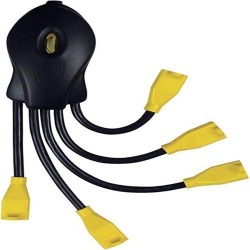
"That's incredibly fascinating, but what", an astute reader of blog titles might ask, "does any of this have to do with squids or cables?"
And he or she would have a good point. What, indeed, does any of this have to do with squids? Or cables?
You know how sometimes, in the middle of a conversation, someone will casually mention something that they take totally for granted, something so utterly familiar that they assume you know exactly what they are talking about, but you have never heard of it before? (I once had a friend who was completely charmed and amused by the phrase, "Six of one; half-dozen of the other". He had somehow gone through his entire life without ever hearing the saying and was amazed at this cool and potentially useful new aphorism.)
I recently had that experience with a surge protector.
I had a visitor to my classroom a few weeks ago. He was impressed with the work my students had done and the cool things we were working on, but what really grabbed his attention and engaged his enthusiasm was my power squid.
Have you ever tried to plug several pieces of equipment into a conventional power strip - a projector, a laptop computer and a set of speakers, for instance - and been frustrated by the bulky box-like plugs that cover up the power sockets and keep you from plugging everything you need into one surge protector?
A "power squid" solves that problem.
Instead of five or six power sockets laid out in a row, a squid (which, it has to be said, does look very squid-like) has five or six tiny extension cords that fan out from a central surge protector and allow you to plug your appliances with power adaptors into individual sockets without blocking access to other outlets.
It's very cool.
Yes, I realize you probably already know about power squids.
But if you don't, Ta DAH!!!!

 RSS Feed
RSS Feed